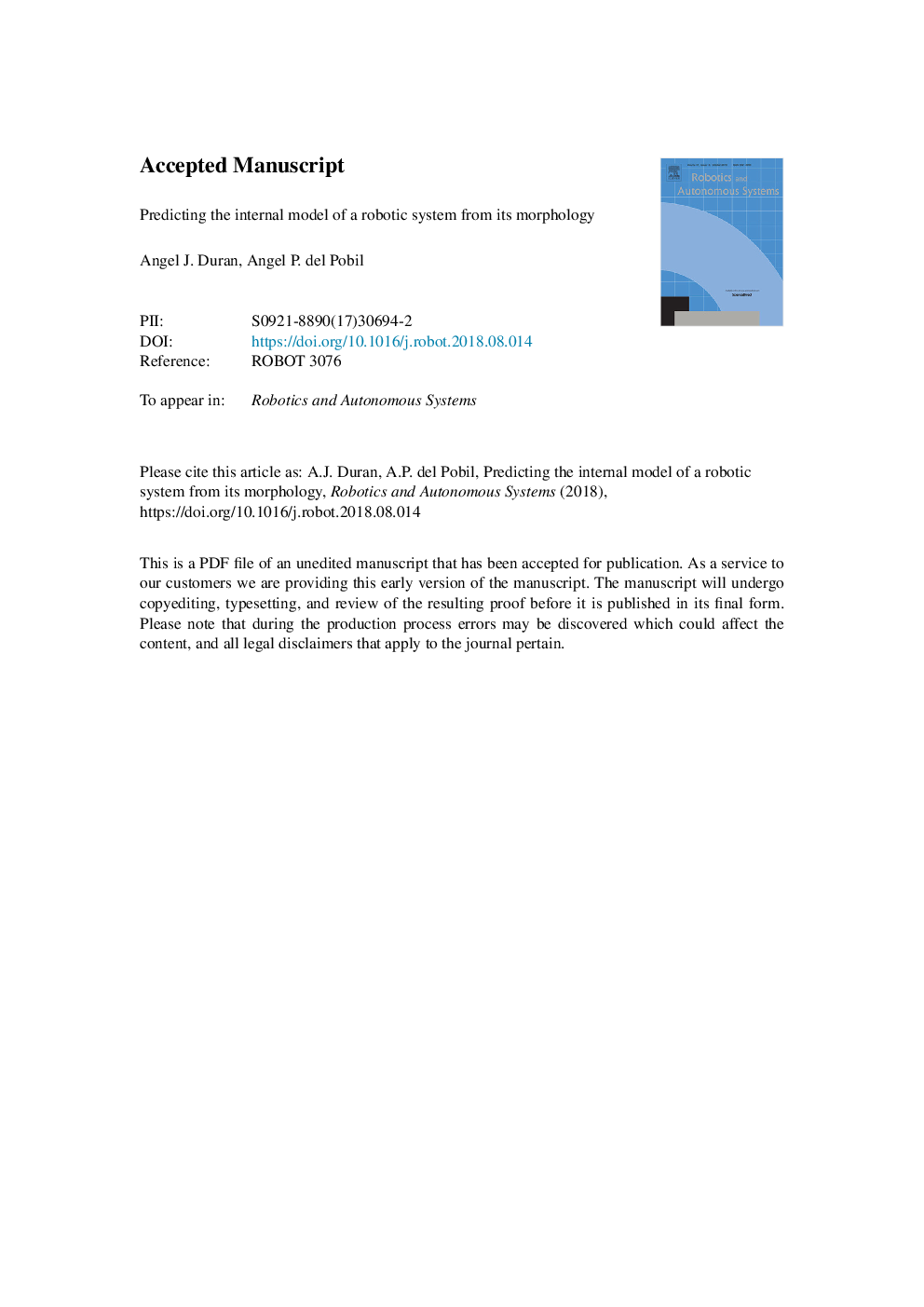| کد مقاله | کد نشریه | سال انتشار | مقاله انگلیسی | نسخه تمام متن |
|---|---|---|---|---|
| 11023970 | 1701204 | 2018 | 21 صفحه PDF | دانلود رایگان |
عنوان انگلیسی مقاله ISI
Predicting the internal model of a robotic system from its morphology
ترجمه فارسی عنوان
پیش بینی مدل داخلی یک سیستم رباتیک از مورفولوژی آن
دانلود مقاله + سفارش ترجمه
دانلود مقاله ISI انگلیسی
رایگان برای ایرانیان
کلمات کلیدی
یادگیری مدل، مدل داخلی، مرفولوژی، شبکه های عصبی، آموزش تصویری،
ترجمه چکیده
برآورد مدل داخلی یک سیستم رباتیک از تعامل مورفولوژی آن، حسگرها و محرک ها با محیط خاص است. تکنیک های یادگیری مدل، بر اساس یادگیری ماشین های تحت نظارت، برای تعیین مدل داخلی گسترده هستند. محدودیت مهمی از چنین رویکردهایی این است که هنگامی که یک مدل آموخته شود، هنگامی که ریشه های ربات تغییر می کند، به درستی رفتار نمی کند. از این به این معنی است که رابطه بین آنها باید وجود داشته باشد. ما یک مدل برای این همبستگی بین مورفولوژی و پارامترهای مدل داخلی ارائه می دهیم، به طوری که در صورت تغییر پارامترهای مورفولوژیکی یک مدل داخلی جدید می توان پیش بینی کرد. برای رفع این مشکل رگرسیون ابعادی، معماری های مختلف شبکه عصبی پیشنهاد می شود. یک مطالعه موردی به طور دقیق مورد تجزیه و تحلیل قرار گرفته است تا نشاندهنده و ارزیابی عملکرد این رویکرد، یعنی یک سر ربات پان کشی انجام حرکات ساکاتیک. بهترین نتایج برای معماری با شبکه های عصبی موازی به دست می آیند. نتایج ما می تواند در رشته های پیشرفته ای مانند ربات های قابل تنظیم خود، تحقیق مجدد، سیستم های روباتیک سایبر فیزیکی و یا روباتیک ابر، که در آن مدل های داخلی به عنوان دانش مشترک به کار می رود، می تواند نقش مهمی ایفا کند، به طوری که روبات هایی با مورفولوژی های مختلف می توانند به راحتی یک رفتار خاص در یک محیط مشخص نمایش می دهد.
موضوعات مرتبط
مهندسی و علوم پایه
مهندسی کامپیوتر
هوش مصنوعی
چکیده انگلیسی
The estimation of the internal model of a robotic system results from the interaction of its morphology, sensors and actuators, with a particular environment. Model learning techniques, based on supervised machine learning, are widespread for determining the internal model. An important limitation of such approaches is that once a model has been learnt, it does not behave properly when the robot morphology is changed. From this it follows that there must exist a relationship between them. We propose a model for this correlation between the morphology and the internal model parameters, so that a new internal model can be predicted when the morphological parameters are modified. Different neural network architectures are proposed to address this high dimensional regression problem. A case study is analyzed in detail to illustrate and evaluate the performance of the approach, namely, a pan-tilt robot head executing saccadic movements. The best results are obtained for an architecture with parallel neural networks. Our results can be instrumental in state-of-the-art trends such as self-reconfigurable robots, reproducible research, cyber-physical robotic systems or cloud robotics, in which internal models would available as shared knowledge, so that robots with different morphologies can readily exhibit a particular behavior in a given environment.
ناشر
Database: Elsevier - ScienceDirect (ساینس دایرکت)
Journal: Robotics and Autonomous Systems - Volume 110, December 2018, Pages 33-43
Journal: Robotics and Autonomous Systems - Volume 110, December 2018, Pages 33-43
نویسندگان
Angel J. Duran, Angel P. del Pobil,
